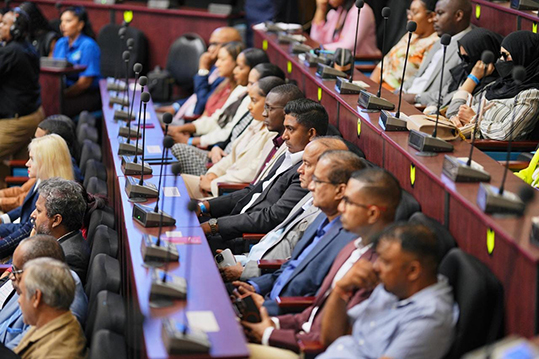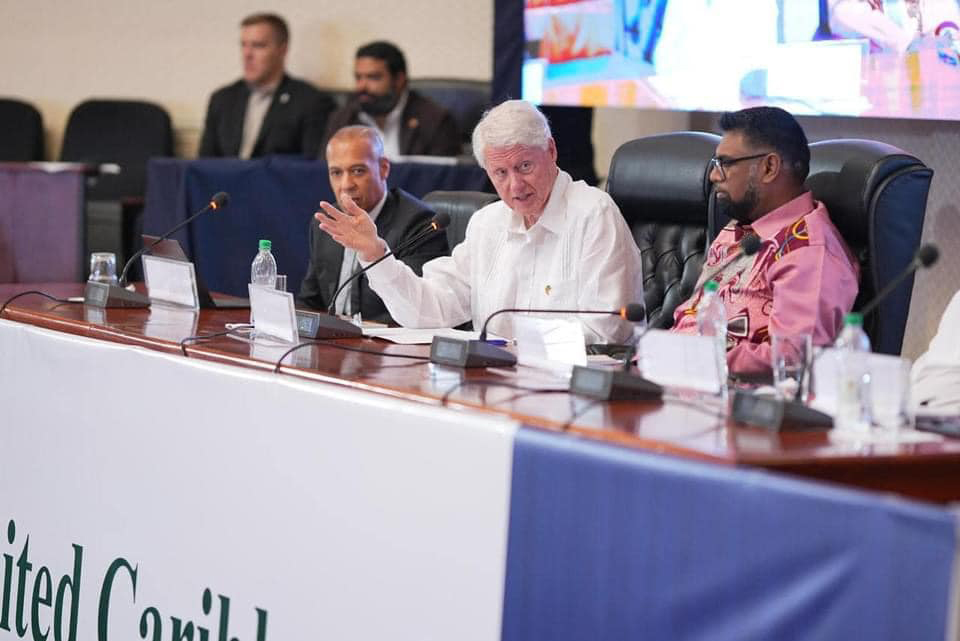`This partnership between governments and businesses and NGOs, between the Dominican Republic, and Guyana, I hope is the tip of the iceberg. I hope it will give new life to CARICOM…’
Former United States President, Bill Clinton yesterday pledged his assistance to help President Irfaan Ali should he want to spread his plans for unity here and will use his influence in New York to make those platforms possible.
The former two-term Democrat President said that since he left office, he has spent his time trying to forge global unity and wants to see the Caribbean as a region that stands as one. As such he is prepared to assist the Dominican Republic and Guyana in fostering relations that will benefit all of the Caribbean Community (CARICOM).
“If I or my foundation – The Clinton Global Initiative – can help, I want to help. If we can offer you a forum, in New York during UN Week, to get the message who you are and what you stand for, what you are trying to do and the unity you are trying to build, we want to do that,” Clinton told Ali in an address at United Carib-bean Forum, which was held yesterday morning at the Arthur Chung Conference Centre.

The event was organised by the Dominican Republic (DR) Chamber of Commerce in Guyana and Santo Domingo, in collaboration with the Govern-ment of Guyana. Present yesterday were envoys from the United States, Canada, United Kingdom, the European Union, and a number international partners.
Clinton disclosed that he had spent “a staggering amount of time” in the Dominican Republic since he left office 25 years ago and that some of his best friends are there. From his interactions with Carib-bean people, he believes that they have the potential to achieve great things and that the Americas need to work closely together.
“I have believed for a long time that the Americas need to work more closely together and, in many ways, the smallest countries. by population, are the most successful where economies of scale are not as important as personal contacts and personal responsibility but it is hard to raise the capital to take all of the small countries forward, together, so you have this curious dilemma where in theory the smallest countries could be the most successful at anything, simply because there is more personal contact,” he expressed.
However he pointed out that while there is admirable contact-to-contact relations in the smaller countries, getting investors for some projects such as green energy initiatives has been a bugbear, possibly because of the small amounts of people living there. “It is hard to get people sometimes to invest, say in solar…” he noted.
For the budding relationship between Georgetown and Santo Domingo, he hopes it blossoms for CARICOM’s benefit.
“This partnership between governments and businesses and NGOs, between the Dominican Republic, and Guyana, I hope is the tip of the iceberg. I hope it will give new life to CARICOM, and new life to any other organisations that are active here, because you have this amazing opportunity to blend the strength of numbers with the strength of individual gifts…,” he said.
“I hope I can come back a lot. But if I don’t, just remember, we are almost always stronger together, we are almost always better cooperating than we are fighting, and we are almost always better emphasising things that make us feel bigger, and trying to make, even our adversaries feel small. This is a big good thing, and I hope we can give life to it after this conference,” he added.
Meanwhile, President Irfaan Ali thanked Clinton for his support while reassuring that Guyana will continue its bilateral relationship with the Dominican Republic and will build on their strengths.
“We must first position where Guyana is today as against where the Dominican Republic is and where we would like Guyana to be in the next 10 years, and the next 15 years. Definitely, we will all agree that we are not where we should be…when you measure us against the global scale. What do I mean? There’s definitely a gap where we are and where the best in the world is today. There’s a technological gap. There’s a human resource gap, there’s a services gap, there is a bureaucracy gap and there is a capability and capacity gap…,” he said, noting that the gaps are both in public and private sector.
And according to Ali, this is the reason the country is adopting an approach of “building tomorrow today.”
Straight line
“So here in Guyana, we are positioning ourselves to build tomorrow today. By that, we have acknowledged that there are gaps, but we also acknowledge that we don’t have the time to work in a straight line manner to bridge those gaps. So we are applying world-class technology, world-class methods, best practices globally, that exists not today, that exists for tomorrow, we are applying that today. So that will reduce the lag time to which Guyana will catch up with the rest of the world, and more importantly, take a lead position on many issues. And it is for this reason, we see the DR as a critical part, in bridging this gap,” he noted.
“When you speak about tourism, scale and capacity in the private sector, leveraging capital, looking at the value-added industry, in food production, all of these things the DR would have not mastered, but have developed tremendous capacity and capability in. We see great synergy in the government and the private sector, working together in aligning those synergies and expanding the opportunities. In the food ecosystem, we have a tremendous opportunity to align what you do in DR with what we do here, because we have the most arable land, we have abundant freshwater that is dumped. We have here, four times more than anyone in the region in aquaculture. So if we are to apply this with the technology that exists already in the DR, then we can build a food ecosystem here that is second to none,” he added.
Pointing to the potential that Brazil has as a market to this country, he posited that as Guyana builds infrastructure and expands its ports to make northern Brazil viable, it would position this “to be not only a bridge, but an opportunity for expansion in Brazil, and expansion in DR.”
Ali said that the Clinton Foundation was privy to this country’s Low Carbon Development Strategy and former President Bharrat Jagdeo, had worked with Clinton “in bringing forest countries and forests on the agenda.”
“Today, this has the capacity and the capability of opening up a whole wealth of opportunities for livelihood, economic growth, for wealth creation, and we’re not even speaking about the biodiversity aspect. Because in the last 50 years, the world has lost 65 per cent of this biodiversity [but] we have kept our biodiversity intact. Very soon the world must come to the understanding that there is a value to that and we have to ensure that when evaluation is done, our product is positioned in a way to create a new area of revenue,” he contended.
“So climate for us is not only about the lofty speeches. It is about real action and real work in positioning our country as a leader in the climate agenda. Energy for us is also a major issue. But for us, it’s not only about petroleum, it is how we build out the transport and logistics sector, how we integrate our energy infrastructure, and how do we use our energy assets to push regional expansion, regional growth, but more importantly, to connect the region. So we want Guyana to be that corridor of energy that connects and bring the region together and we have that potential,” Ali added.





